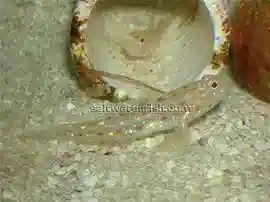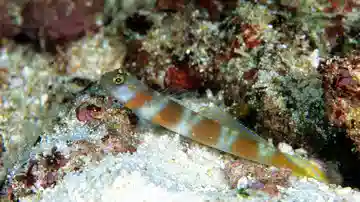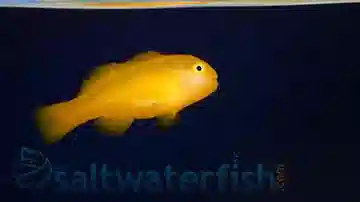Yellow Clown Goby
Gobiodon okinawae
(6 Reviews)

Yellow Clown Goby
Gobiodon okinawae
(6 Reviews)
{{ item.name }}
Size: {{ item.extra_field_3 }}
${{ getFormattedPrice(item.saleprice) }} ${{ getFormattedPrice(item.price) }}
To join the waiting list, click here
Free Shipping
With
$199.00
or more in Marine Life.
More details...
Yellow Clown Goby Care Facts
| Care Level: | Easy |
|---|---|
| Temperament: | Peaceful |
| Diet: | Carnivore |
| Reef Safe: | Yes |
| Minimum Tank Size: | 10 gallons |
| Max Size: | 2 inches |
The Yellow Clown Goby, Gobiodon okinawae, also known as the Yellow Goby, is a small, peaceful fish that is easy to care for. It features a yellow/orange body with unique markings across its face. They can be kept singly or in pairs. Like other Goby species, the Yellow Clown Goby will often create its own burrow in the sand - sometimes these burrows are shared in a symbiotic relationship with the Pistol Shrimp. Therefore, a tank with plenty live rock, a sandy substrate, and a tightly sealed lid to prevent escapes is recommended. The Yellow Clown Goby should not be housed with larger predatory fish for its small size could easily make it prey. They will take a carnivorous diet of small frozen foods.
Yellow Clown Goby (Gobiodon okinawae): A Captivating Addition to Your Marine Aquarium
The Yellow Clown Goby, scientifically known as Gobiodon okinawae, is a fascinating addition to saltwater marine aquariums. This educational and formal product description provides essential information for enthusiasts looking to keep this unique species in their aquariums.
Yellow Clown Goby: A Splash of Vibrant Yellow
The Yellow Clown Goby is a small-sized fish native to the Indo-Pacific region, specifically found in the waters around Okinawa. This species is renowned for its vibrant yellow coloration and distinctive markings, making it a visually appealing choice for aquarium enthusiasts.
Habitat of the Yellow Clown Goby: Recreating Nature in Your Tank
The Yellow Clown Goby prefers sheltered areas such as coral reefs and rocky crevices in its natural habitat. When recreating its environment in captivity, it is essential to provide ample hiding spots and suitable structures to mimic its natural habitat.
Reef Compatibility of the Yellow Clown Goby: A Harmony with Corals
This species is considered reef-safe, making it an excellent choice for reef aquariums. The Yellow Clown Goby is known to peacefully coexist with various corals and invertebrates, enhancing the overall aesthetic of the tank.
Size and Lifespan of the Yellow Clown Goby: Small Marvels for Your Aquarium
Yellow Clown Gobies typically reach a maximum size of around 1.5 inches, making them suitable for smaller aquariums. These gobies can live 3 to 5 years in captivity with proper care.
Diet of the Yellow Clown Goby in Captivity: A Varied and Balanced Menu
Feeding the Yellow Clown Goby is relatively straightforward. They are omnivores, and their diet should include a mix of high-quality flake or pellet food supplemented with live or frozen brine shrimp, copepods, and other small invertebrates.
Aquaculture and Availability of the Yellow Clown Goby: Responsible Choices for Your Aquarium
The Yellow Clown Goby is currently aquacultured, contributing to sustainability in the hobby. This means hobbyists can find responsibly bred individuals, reducing the impact on wild populations. Saltwaterfish.com proudly offers aquacultured Yellow Clown Gobies, ensuring a responsible and environmentally friendly choice for enthusiasts.
Compatibility of the Yellow Clown Goby with Other Fish and Invertebrates: Building a Peaceful Community
These gobies are generally peaceful but can be territorial, especially towards their kind. Compatible tank mates include small and peaceful species like the Firefish Goby, Yasha Shrimp Goby, and the Royal Gramma. Avoid housing them with aggressive or larger fish to prevent potential conflicts.
Sexual Dimorphism of the Yellow Clown Goby: Subtle Differences
Sexual dimorphism in Yellow Clown Gobies is minimal, with males and females displaying similar external characteristics. Therefore, distinguishing between the sexes based on appearance alone can be challenging.
Juvenile to Adult Coloration Changes in the Yellow Clown Goby: Consistent Vibrancy
The Yellow Clown Goby undergoes minimal color changes from juvenile to adult stages. Their vibrant yellow coloration remains consistent throughout their life, adding color to any aquarium.
Temperament of the Yellow Clown Goby: Calm Contributors to Serenity
These gobies exhibit a calm temperament, making them suitable for community aquariums. However, as mentioned earlier, territorial behavior may be observed, so providing ample hiding spots is essential to prevent conflicts.
Tank Requirements for the Yellow Clown Goby: Creating a Home for Yellow Beauty
- Minimum Aquarium Size: A tank with a minimum capacity of 10 gallons is recommended.
- Structures: Provide ample live rock structures, caves, and hiding places.
- Conditions: Maintain stable water conditions with proper filtration and regular water changes.
Water Conditions for the Yellow Clown Goby: Mimicking the Natural Habitat
- pH: Maintain a pH level between 8.1 and 8.4.
- Salinity: Keep salinity levels in the range of 1.023 to 1.025.
- Water Temperature: Maintain a temperature range of 74°F - 78°F.
- Water Flow: Keep water flow low to moderate.
Other Common Names for the Yellow Clown Goby: Okinawa Goby, Yellow Coral Goby
The Yellow Clown Goby is known by other common names, including Okinawa Goby and Yellow Coral Goby.
Five Compatible Tank Mates: Building a Harmonious Community
- Firefish Goby (Nemateleotris magnifica)
- Yasha Shrimp Goby (Stonogobiops yasha)
- Royal Gramma (Gramma loreto)
- Banggai Cardinalfish (Pterapogon kauderni)
- Clownfish (Amphiprion ocellaris)
Why Choose Yellow Clown Goby from Saltwaterfish.com: Trustworthy Source for Your Aquarium
Saltwaterfish.com is a reputable source for marine aquarium livestock. You are guaranteed healthy, aquacultured specimens when you purchase Yellow Clown Gobies from Saltwaterfish.com. The company prioritizes sustainability and ethical practices, ensuring that your purchase contributes to the well-being of the species and the conservation of marine ecosystems.
In conclusion, the Yellow Clown Goby is a captivating and manageable species for saltwater aquarium enthusiasts. Its vibrant coloration, compatibility with reef environments, and availability through responsible aquaculture make it a top choice for those looking to enhance the beauty of their marine tanks. Purchase from Saltwaterfish.com for a reliable source of these delightful gobies and contribute to the sustainability of the hobby.
When this one arrived he appeared a bit white, but once I added it to the tank. His yellow color brightened up and he is very active
Reviewed by: Doug on Oct. 29, 2024
Adorable!!! Fun to watch!! Can hover like a boss !!! Really, really cute !!!!
Reviewed by: Michael Mallard on July 3, 2024
Buy two. Easy to get the mm to spawn on branching coral and good water qualities. If you research you can successfully breed these and hatch the eggs. Raise with proper live Copepods or other live feed. Research
Reviewed by: Hodad on July 14, 2023
First one arrived DOA. Saltwater promptly refunded us. Eventually ordered another one when we ordered our anemone. Arrived healthy and has been eating. Very cool little guy. Very happy so far.
Reviewed by: Johnny Cope on July 8, 2017
Of all the fish I own, this little guy is my favorite. I named mine Peeps because he's yellow like the Easter Peeps candy and because he sits in the strangest places peeping out and watching the rest of his tankmates! He is a fearless and friendly fish. Oftentimes he will sit on top of my hand while I'm cleaning the tank or moving a coral. Pure pesonality!
Reviewed by: Barbara on Nov. 28, 2016
I had two of these little guy's and my wife named them Fritz and Frank. They do have a tremendous amount of personality!However , when I moved them into a larger tank, Frank murdered fritz.Do not know why. perhaps Fritz pissed off frank. We'll never know. frank continues to be a good tank mate to the other fish though. Just keep one in a tank.
Reviewed by: Steve Wieters on Dec. 31, 2011















